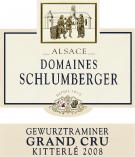History
Kitterlé was distinguished right from 1699. In 1782, twelve “schatz” of vines turned out to belong entirely to the Jesuits from Ensisheim. It has been sold under its own name since 1830.
Location
This volcanic-sandstone plot is on a unique site, on a steeply sloping rocky outcrop facing three ways (south-west, south and south-east). The light, sandy soil, which is kept back by huge drystone walls, only gives very low yields.
Wine-making
Manual harvest the 26th October 2008. Whole grape pressing, static racking. Fermentation in thermo-regulated tuns for one to four months. Maturation on fine lees for 8 months. Bottled 15th April 2010.
Gastronomy
Serve with : spicy tapas, Indian food, desserts…
Exemples : marinated chicken with curry, tarte tropézienne…
Serve at a temperature of 12°C.
Learn more about food & wine pairing
Tasting
The colour is straw yellow with hints of white gold. The disc is thick, the legs are generous.
The first olfactory contact is delicate and refined, with a beautiful intensity. I detect notes of bitter orange and a range of spices dominated by cumin and saffron.
After aeration, the spices assert themselves further with scents of white pepper and cardamom. An exotic touch of fresh mango complements this aromatic variety. The nose is complex and very elegant.
The onset on the palate is clear and introduces a smooth wine. The delicate freshness integrates first in a fatty taste in the mouth marked by a fully mastered sweetness that then provides a feeling of freshness. The aromas succeed delectably. Thus, the orange honey aromas are followed by yellow fruits such as nectarines and leaves room for spices like cumin and cardamom. The length of 6 to 7 caudalies narrows to express a touch of smoke and eucalyptus, providing a feeling of palatability. A refined and complex palate.















